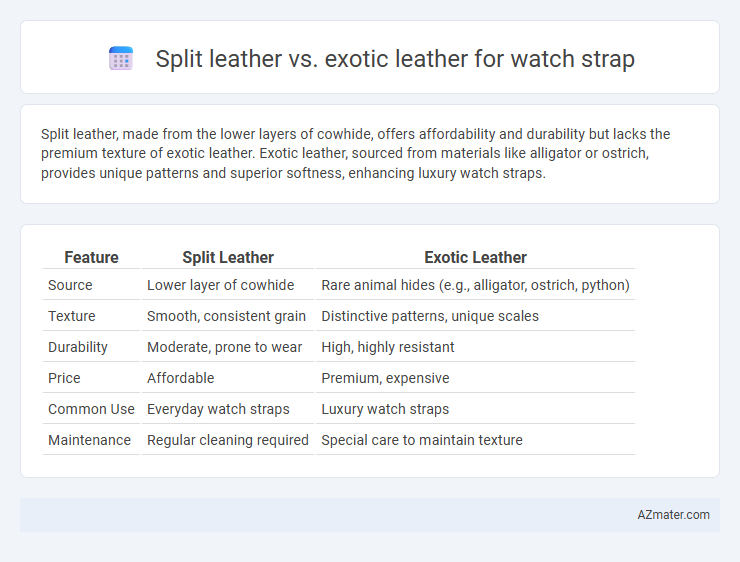Split leather, made from the lower layers of cowhide, offers affordability and durability but lacks the premium texture of exotic leather. Exotic leather, sourced from materials like alligator or ostrich, provides unique patterns and superior softness, enhancing luxury watch straps.
Table of Comparison
| Feature | Split Leather | Exotic Leather |
|---|---|---|
| Source | Lower layer of cowhide | Rare animal hides (e.g., alligator, ostrich, python) |
| Texture | Smooth, consistent grain | Distinctive patterns, unique scales |
| Durability | Moderate, prone to wear | High, highly resistant |
| Price | Affordable | Premium, expensive |
| Common Use | Everyday watch straps | Luxury watch straps |
| Maintenance | Regular cleaning required | Special care to maintain texture |
Introduction to Watch Strap Materials
Split leather, derived from the lower layers of a hide, offers affordability and durability but lacks the premium texture of top-grain leather, making it a common choice for budget watch straps. Exotic leather, sourced from unique animals such as alligator, ostrich, or python, brings distinctive patterns and luxurious appeal, often enhancing the watch's elegance and status symbol. Selecting the right watch strap material depends on balancing aesthetics, durability, and cost, with split leather catering to practicality and exotic leather emphasizing exclusivity.
What is Split Leather?
Split leather is derived from the lower layers of a hide after the top grain has been separated, resulting in a softer but less durable material often used for budget-friendly watch straps. Unlike exotic leather, which comes from unique animal skins like alligator or python and features distinctive patterns and higher durability, split leather lacks natural grain and is frequently coated or embossed to mimic premium textures. Choosing split leather for watch straps prioritizes affordability and flexibility but sacrifices the luxury appearance and longevity found in exotic leather options.
Understanding Exotic Leather Types
Exotic leather for watch straps includes materials like alligator, crocodile, ostrich, and lizard, prized for their unique textures, natural patterns, and durability. Split leather, derived from the fibrous lower layers of the hide, is less expensive but lacks the refined grain and luxurious appeal found in exotic leathers. Choosing exotic leather often elevates a watch's aesthetic and value due to its rarity and high-quality tanning processes.
Durability: Split Leather vs Exotic Leather
Split leather is made from the lower layers of a hide, making it less durable and more prone to wear and tear compared to exotic leather. Exotic leather, sourced from animals like alligators, ostriches, or snakes, boasts unique fiber structures that provide superior strength and longevity for watch straps. The inherent toughness and resistance to environmental factors make exotic leather a preferred choice for long-lasting, high-quality watch straps.
Appearance and Aesthetic Differences
Split leather watch straps exhibit a more uniform texture with a consistent matte finish, often resulting in a subdued and understated aesthetic. Exotic leather straps, such as those made from alligator, ostrich, or python, feature distinctive natural patterns and a glossy sheen that enhance luxury and visual complexity. The unique scales and textures of exotic leather create a striking and sophisticated appearance, making these straps highly sought after for high-end timepieces.
Comfort and Wearability
Split leather watch straps offer moderate comfort and flexibility due to their inner layer composition but tend to be less breathable and may wear out faster compared to top-grain leather. Exotic leather straps, such as alligator, ostrich, or python, provide superior durability, unique texture, and enhanced comfort through natural breathability and softness. Consumers seeking long-lasting wearability with a luxurious feel often prefer exotic leather for its combination of style and comfort in watch straps.
Price Comparison
Split leather watch straps generally offer a more affordable alternative compared to exotic leather options like alligator, ostrich, or python, which command premium prices due to their rarity and distinctive texture. While split leather is derived from the lower layers of the hide and tends to have a shorter lifespan, its cost-effectiveness makes it popular for budget-conscious consumers. Exotic leather straps often exceed $200, reflecting craftsmanship and exclusivity, whereas split leather is commonly priced under $50.
Maintenance and Care Requirements
Split leather watch straps require regular conditioning to prevent drying and cracking due to their fibrous structure, and they are more susceptible to wear from moisture and sweat. Exotic leather straps, such as alligator or ostrich, demand specialized care with gentle cleaning products to preserve their unique textures and natural oils, reducing the risk of damage from harsh chemicals. Both types benefit from avoiding prolonged exposure to water and sunlight, but exotic leathers generally maintain durability longer with proper maintenance.
Sustainability and Ethical Considerations
Split leather, derived from the lower layers of animal hides, often undergoes extensive processing and chemical treatments, raising concerns about environmental impact and sustainability. Exotic leathers, such as alligator or ostrich, come from regulated sources with stricter controls on animal welfare, but their scarcity and high demand can contribute to ethical debates and overexploitation. Choosing watch straps made from responsibly sourced hides or alternative sustainable materials offers a more ethical and environmentally friendly option in the luxury accessory market.
Which Leather is Best for Your Watch Strap?
Full-grain leather offers superior durability and ages beautifully, making it ideal for watch straps that require longevity and a classic appearance. Exotic leathers such as alligator, ostrich, or python provide unique texture and luxury appeal but demand more care and come at a higher price point. Choosing the best leather depends on your preference for durability, style, maintenance, and budget considerations.

Infographic: Split leather vs Exotic leather for Watch strap
 azmater.com
azmater.com